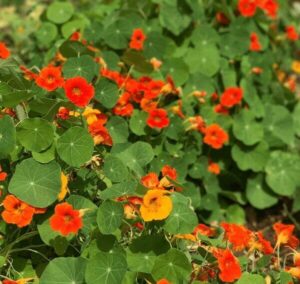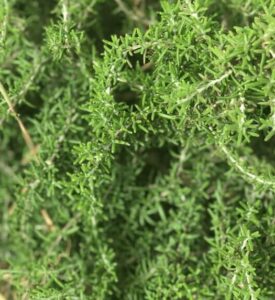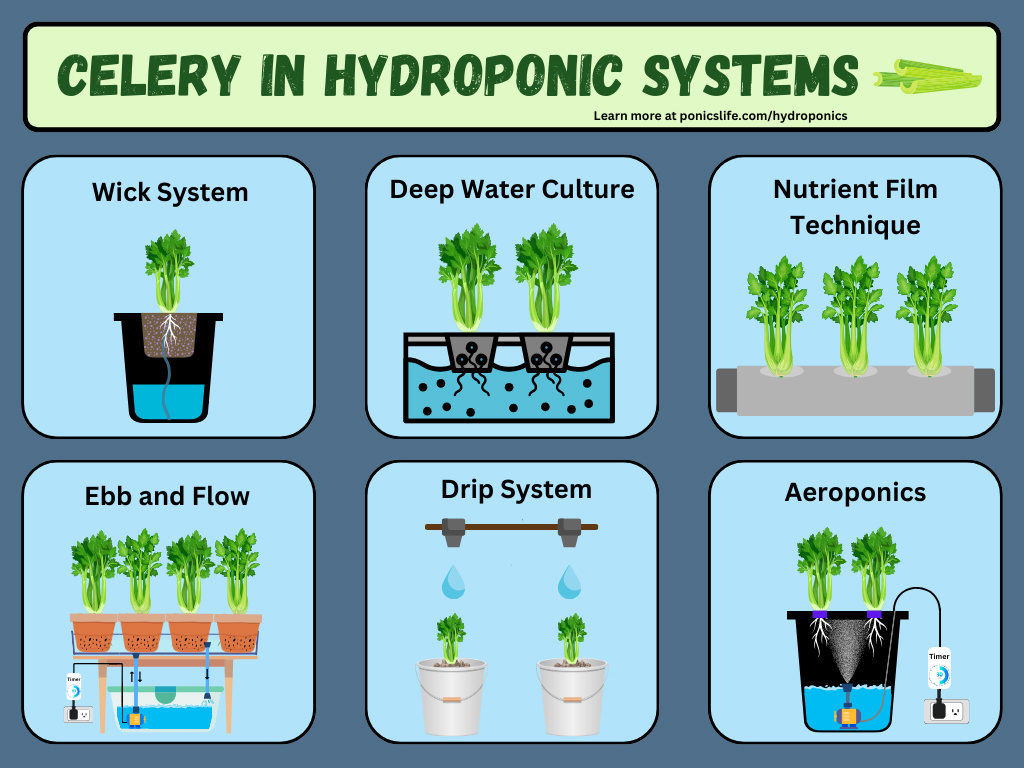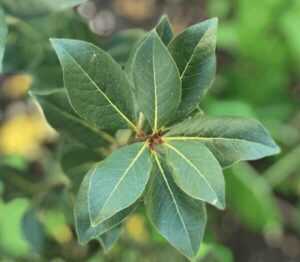https://growinginthegarden.com/arizona-vegetable-planting-guide-a-visual-guide-for-low-desert-vegetables-2/
From roughly October through May in Tucson, herbs that don’t tolerate high temperatures grow well. These include things like cilantro, parsley, dill, and caraway. When temperatures creep up, these herbs bolt, which means that they flower and then die. To keep these plants going next season, remove the winter herbs in May and save their seeds. Replace them with herbs that can tolerate the Tucson summer heat. Herbs that grow well in the heat include basil, lemon balm, lemon verbena, oregano, mint, and garlic chives. Mexican mint marigold—also referred to as Texas tarragon and winter tarragon—is a heat-loving version of tarragon that is well suited to Tucson’s summer climate.
Landscaping Herbs
Herbs that can grow year-round in Tucson are easily integrated into landscaping. A popular example of this is rosemary, which many people in the region use for groundcover in their landscaping. Germander (Teucrium chamaedrys) is another popular choice for this purpose, as is lavender.
 If you opt for lavender, stay away from English varieties and look for French (photo at left) or Spanish lavender (lavender pink), which will be better suited to the climate in Tucson. Some summer herbs, such as lemon verbena and lemon grass, can be used for landscaping as well, if they are planted in protected areas and covered in the case of frost.
If you opt for lavender, stay away from English varieties and look for French (photo at left) or Spanish lavender (lavender pink), which will be better suited to the climate in Tucson. Some summer herbs, such as lemon verbena and lemon grass, can be used for landscaping as well, if they are planted in protected areas and covered in the case of frost.
Arizona has two planting seasons—a cool season (September through mid-November) and a warm season (mid-February through March).
Cool-season annuals include cilantro (coriander), dill, German chamomile and garlic and; while basil, epazote and summer savory are warm-season annuals. Sep 21, 2021
You can grow a respectable herbal apothecary in pots. In fact, some of the most beneficial medicinal herbs will positively thrive in containers placed right on your porch or patio.
Plant bay in Late February – April
Harvest dark leaves anytime. Use within 3-4 months for best flavor. Perennial. New plantings are frost-tender.
Borage:
grows best from seed
When to plant : October – January
Harvest young stems for best flavor. Pick flowers and use fresh, frozen, or dried.
Cool-season annual. Self-seeds readily. Attracts pollinators. Plant with squash, strawberries, and tomatoes.
 Calendula:
Calendula:
Grows best from seed or transplant
When to plant calendula in Arizona: Late September – November
Harvest flowers regularly when young and fresh.
Good to know: Cool-season annual. Edible, and medicinal uses. Reseeds easily. Early bloomer. Often grown as a trap crop for aphids. Keep deadheaded to encourage blooms.
 Chamomile:
Chamomile:
Grows best from seed or transplant; reseeds readily
Plant chamomile in Arizona: October – March
Harvest chamomile when the petals are flat or beginning to fall back from bud. Air-dry or dry in a dehydrator.
Cool-season annual. Grows best in cooler weather. Improves the flavor of cabbage and onions.
 Chives:
Chives:
Grows best from seed or division
When to plant chives in Arizona: October – April
Harvest by cutting leaves at the base.
Low-growing perennial; beautiful when flowering. Divide plants in the fall or early spring. Improves the growth and flavor of carrots.
 Dill:
Dill:
Grows best from seed; handle transplants carefully; reseeds readily
When to plant dil in Arizona: October – January
Use leaves fresh or dried. Let seed ripen on plant before harvesting. Bouquet dill has large seed heads. Fern-leaf dill has large plants for using fresh leaves.
Cool-season annual. Attracts swallowtail caterpillars. Trap crop for aphids; can attract ladybugs.
 Ginger:
Ginger:
Grows best from rhizomes
When to plant ginger in Arizona: March
Harvest ginger about 10 months after planting by carefully digging out rhizomes.
Ginger needs a long warm growing season to grow well. Provide shade to protect leaves from sunburn. Harvest when leaves turn yellow and die back.
 Lemon Grass:
Lemon Grass:
- Grows best from division or transplant
- When to plant lemon grass in Arizona: February – April
- Harvest the fresh leaves and stems of single stalks as needed.
- Perennial. Grows well year-round in the low desert of Arizona.
-
 Nasturtium:
Nasturtium:
Grows best from seedWhen to plant nasturtiums in Arizona: October – JanuaryHarvest leaves and flowers just before using. Harvest seed pods just before they turn from green to brown. Cool-season annual. Overly rich soil results in fewer blooms. Reseeds readily.
-
 Rosemary:
Rosemary:
Grows best from cutting or transplant.
- When to plant rosemary in Arizona: October – January
- Harvest stems as needed anytime. Best flavor is just before flowers appear. Drought-tolerant perennial. Takes full sun but needs well-drained soil. Cutting back by more than 1/3 can shock plant. Grows up to 6 feet tall. Good companion plant to cabbage, beans, carrots, and sage. Deters cabbage moths, bean beetles, and carrot flies.
 Turmeric:
Turmeric:
Grows from rhizomes
- When to plant turmeric in Arizona: March
- Harvest turmeric about 10 months after planting by carefully digging out rhizomes.
- Prefers shade when grown in Arizona. Keep an eye on moisture levels. Can rot if too wet, but needs regular water and feeding to grow well.




















 The Black Swallowtail caterpillars have thicker, green stripes and yellow, wavy “dots”. They also don’t have the long tentacles on their head and tail end like Monarch caterpillars do.
The Black Swallowtail caterpillars have thicker, green stripes and yellow, wavy “dots”. They also don’t have the long tentacles on their head and tail end like Monarch caterpillars do. How to keep the caterpillars happy and not lose all of your plants or resort to using pesticides!
How to keep the caterpillars happy and not lose all of your plants or resort to using pesticides!
 If you opt for lavender, stay away from English varieties and look for French (photo at left) or Spanish lavender (lavender pink), which will be better suited to the climate in Tucson. Some summer herbs, such as lemon verbena and lemon grass, can be used for landscaping as well, if they are planted in protected areas and covered in the case of frost.
If you opt for lavender, stay away from English varieties and look for French (photo at left) or Spanish lavender (lavender pink), which will be better suited to the climate in Tucson. Some summer herbs, such as lemon verbena and lemon grass, can be used for landscaping as well, if they are planted in protected areas and covered in the case of frost.

 Anise:
Anise: Bay:
Bay:
 Calendula:
Calendula: Chamomile:
Chamomile: Chives:
Chives: Dill:
Dill: Ginger:
Ginger: Lemon Grass:
Lemon Grass: Nasturtium:
Nasturtium: Rosemary:
Rosemary: Turmeric:
Turmeric:


 Moonshine yarrow: Achillea x ‘Moonshine’
Moonshine yarrow: Achillea x ‘Moonshine’

 The soil pH value is a measure of soil acidity or alkalinity. Soil pH directly affects nutrient availability. The pH scale ranges from 0 to 14, with 7 as neutral. Numbers less than 7 indicate acidity while numbers greater than 7 indicate alkalinity.
The soil pH value is a measure of soil acidity or alkalinity. Soil pH directly affects nutrient availability. The pH scale ranges from 0 to 14, with 7 as neutral. Numbers less than 7 indicate acidity while numbers greater than 7 indicate alkalinity.












